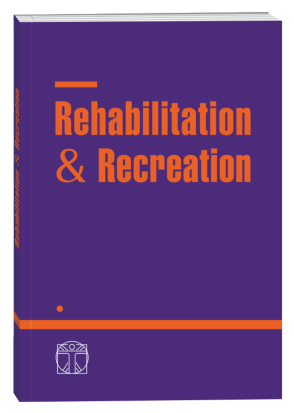IMPROVING BACKSTROKE SWIMMING TECHNIQUE BY USING UNCONVENTIONAL OBJECTS
DOI:
https://doi.org/10.32782/2522-1795.2024.18.3.21Keywords:
swimming, equipment, training, speedAbstract
Swimming is one of the most important and useful skills, alongside running and walking, that is worth learning at least in its basic form. It is a very enjoyable sport that has a positive impact on our entire body. Swimming is suitable for people of all ages, from the youngest to seniors. It is considered to be one of the healthiest forms of physical activity and has a significant influence on our respiratory, circulatory, and immune systems. Moreover, it is increasingly viewed as a form of relaxation, leading people of all ages to engage in swimming more often. Learning to swim both benefits our health and also enables us to participate in various water sports such as windsurfing, sailing, and kayaking, where we have continuous contact with water. Therefore, many parents enroll their children in swimming lessons from a young age to familiarize them with this element – water. During swimming lessons, children are taught to follow safety rules regarding staying near water and moving in it, so as not to pose a threat to themselves or others. The focus of the research is to study the effects of using unconventional equipment in backstroke swimming technique training. The main objective is to determine whether regular swimming training with unconventional equipment affects changes in the backstroke swimming technique of 10 to 11-year-old children. Two groups were studied: group 1, swimming with cotton gloves, and group 2, swimming without unconventional equipment. The technical training sessions for the backstroke style lasted three weeks, and the progress was evaluated through a 4x25 m timed test before and after the training. The research was conducted with 10 students (5 girls and 5 boys) from the fourth grade of a primary school in Torun, Poland. The results showed that most participants improved their backstroke swimming performance in the second 4x25 m timed test. Some changes in times, speed, stroke length, stroke rate, and technique index were significant. However, it is impossible to attribute these improvements solely to the use of unconventional equipment during training because both groups, Group 1 using cotton gloves and Group 2 without unconventional equipment, improved their results, which were not statistically significant in both groups. In conclusion, after analyzing the research topic and answering the research questions, one main conclusion can be drawn: age, commitment, appropriate exercise selection, and varied training sessions have a significant impact on improving a swimmer’s technical abilities.
References
Bartkowiak E. (1999). Swimming sports: theoretical foundations, swimming technique, swimmer’s motor skills, learning and teaching swimming, training technology. Warsaw, Central Sports Center, pp. 82–90.
Chrościelewski J., Przybylski S., Waade B. (1999). Evaluation of motor coordination level in 10-year-old children undergoing swimming training since the ages of 7 and 9. Swimming and Athletics in School, pp. 53–57.
Czabański B., Fiłon M., Zatoń K. (2003). Elements of swimming theory. Wrocław, AWF Publishing, pp. 16–21.
Ivchenko V., Lytvynenko Y., Aloshyna A., Byshevets N., Grygus I., Kashuba V., Shevchuk O., Byshevets H., Yarmolinsky L. (2023). Dependence of the Parameters of Precision-Target Movements on the Nature of the Movements of Athletes. International Journal of Human Movement and Sports Sciences, 11(5): 985–993. DOI: 10.13189/saj.2023.110506.
Makar P., Skalski D., Peczak-Graczyk A., Kowalski D., Grygus I. (2022). Correlations between chosen physiological parameters and swimming velocity on 200 meters freestyle distance before and after 5 months of training. Journal of Physical Education and Sport, 22(3): 803–810. DOI: 10.7752/jpes.2022.03102.
Morecki A., Ekiel J., Fidelus K. (1971). Bionics of Movement. Warsaw, pp. 10–19.
Mytskan, T.S., Mytskan, B.M., Grygus, I.M. (2023). Biosocial values and functions of physical culture. Rehabilitation and Recreation, 16: 90–103. https://doi.org/10.32782/2522-1795.2023.16.12.
Platonov W.N. (1997). High-performance Training in Swimming. Structure and Programs. Warsaw, Central Sports Center, Resort Methodical-Training Center for Physical Culture and Sports, pp. 39–43.
Przybylski S., Waade B. (1999). Changes in the Level of Motor Coordination in Children during a Two-Year Period of Preliminary Swimming Training. Swimming and Athletics in School, pp. 83–90.
Raczek J., Mynarski W. (1992). Motor Coordination Abilities of Children and Youth: Internal Structure and Individual Variability. Katowice, AWF Publishing House, pp. 56–60.
Raczek J., Mynarski W., Ljach V. (1998). Theoretical and Empirical Foundations for Shaping and Diagnosing Motor Abilities. Katowice, AWF Publishing House, pp. 74–90.
Sankowski T. (1989). Sports Abilities and Talents and Their Influence on Sports Training Individualization. Physical Culture, Issue 7–8, p. 9.
Starosta W. (2003). Motor Coordination Abilities: (Significance, Structure, Determinants, Development). Warsaw, Institute of Sport in Warsaw, 2nd edition, pp. 18–23.
Starosta W. (2006). Global and Local Motor Coordination in Physical Education and Sport. Warsaw, International Sports Motor Skills Association (MSMS), Branch Faculty of Physical Education at the Poznań Academy of Physical Education in Gorzów Wielkopolski, pp. 22–28.
Zabolotna O., Skalski D., Nesterchuk N., Grygus I. (2019). Health-related good of physical culture and health education. Rehabilitation & recreation. 5: 53–58.
Downloads
Published
How to Cite
Issue
Section
License
Copyright (c) 2024 D. W. Skalski, N. Tsyhanovska, P. Kreft

This work is licensed under a Creative Commons Attribution-NonCommercial-NoDerivatives 4.0 International License.











